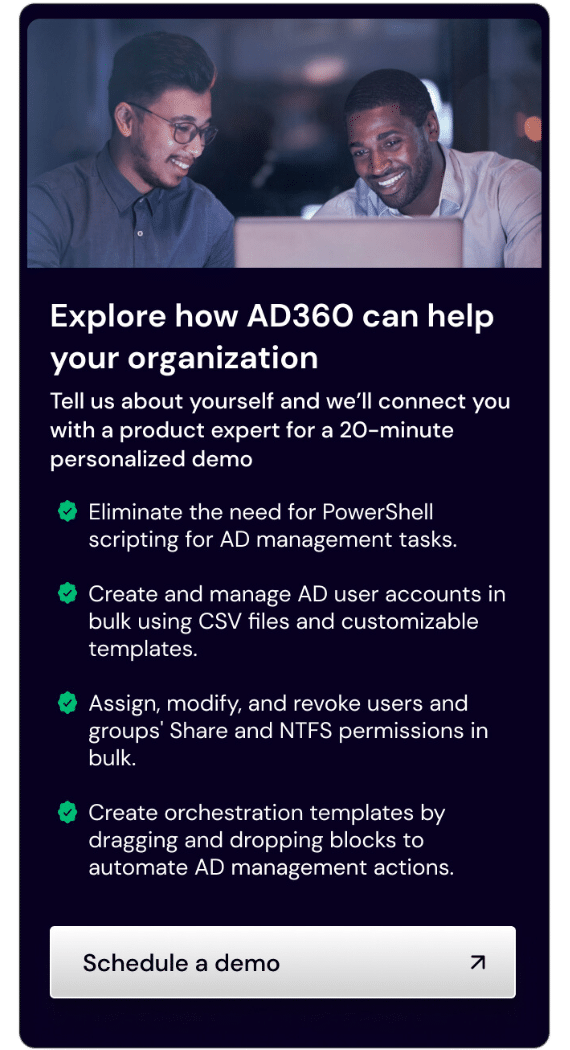
Active Directory 2025 security, availability, and supportability are now the defining pillars of enterprise identity resilience.
Sneak-peek
Here we talk about the latest changes that improve three pillars—availability (staying online), supportability (seeing and fixing issues fast), and security (withstanding and recovering from attacks). Together they reshape how you design, operate, and defend Active Directory in hybrid environments.
On this page
A clearer frame
Active Directory (AD) remains the backbone of identity and access across enterprise Windows environments. Hybrid cloud, zero trust, and modern auth stacks orbit around it. When AD falters, everything wobbles.
In 2025 the expectations are higher: five‑nines logon, rapid root‑cause, and resilient security under active attack. New capabilities and refined practices across availability, supportability, and security move AD from “keep it alive” to “engineer for graceful failure and verified recovery.”
Beyond the surface: fundamentals
It’s common to treat AD as a static directory. In reality it’s a distributed system with impatient clients and unforgiving dependencies. A surface view notes that replication happens, DNS resolves, and Kerberos issues tickets. The complete view recognizes how latency budgets, failure domains, and operational visibility couple these parts.
- Replication must converge quickly enough to keep authentication decisions consistent, but not so aggressively that it floods networks.
- DNS is the hidden backbone. If DNS queries fail or return stale SRV records, AD might look “down” even with healthy DCs.
- Clients are impatient. Logon flows tolerate little latency. Failover that takes seconds can feel like downtime.
These truths explain why 2025 enhancements center on smarter replication controls, global locator caching, and deeper health reporting. The direction of travel: from manual resilience tuning toward self‑tuning consistency.
First principles that drive behavior
- Authentication is an always‑on dependency. Unlike many apps, AD cannot go down without triggering cascade failures. Design for recovery time as much as uptime.
- Supportability equals intervention velocity. You need both transparency and fast, low‑risk ways to act when something looks off.
- Security assumes theft, then contains it. Least privilege, strong audit, and rapid restore are the baseline.
When you embrace these principles, recent feature changes slot naturally into place and you avoid brittle designs that scale complexity faster than reliability.
Availability: engineer for graceful failure
High availability in AD is not just “more DCs.” It’s predictable failover and bounded blast radius. Ask: what breaks when a site link saturates, a DC goes stale, or DNS drifts?
- Revisit replication design: site links, schedules, and cost need to reflect actual traffic and business criticality—not old diagrams.
- Validate locator paths: unhealthy or misweighted SRV records often masquerade as authentication outages.
- Prefer many small failure domains to one large one: RODCs, per‑site DC pairs, and disciplined site topology lower systemic risk.
Rule of thumb: redundancy only works if failover is faster than user patience and slower than replication convergence. Anything else amplifies risk.
Supportability: from reactive to predictive
Supportability improvements rarely make headlines, yet they decide whether a stable environment stays that way. Treat them as preventive medicine.
- Correlate replication health, auth failures, and resource telemetry so you spot drift before users do.
- Don’t just add logs—add questions. What would have made the last incident obvious an hour earlier?
- Codify common fixes: safe, idempotent runbooks shrink time‑to‑mitigation and reduce error rate.
For a practical baseline, start with our Active Directory maintenance checklist and expand with site‑specific signals.
Security: defend, contain, recover
The attack surface keeps evolving. Credential theft attempts are constant, and ransomware crews treat identity systems as high‑leverage targets. The Active Directory 2025 posture assumes compromise and prioritizes containment.
Focus areas
- Least privilege that actually operates. Align tiered admin and JIT access with Entra ID PIM. See: PIM overview.
- Credential hardening by default. Favor Kerberos armoring and Protected Users for sensitive roles. Microsoft’s guidance on armoring and mitigations is a must‑read (Kerberos armoring).
- Trustworthy auditing. Adopt baseline audit policy and protect logs from tampering to preserve forensics (audit policy recommendations).
Authoritative reference: Best practices for securing Active Directory.
The friction between pillars
Availability, supportability, and security often collide.
- More DCs without topology discipline raises change velocity and failure coupling.
- Strict security can bottleneck auth paths or add fragile dependencies if you skip dependency mapping.
- Verbose telemetry without curation can leak metadata and degrade DC performance.
The goal is not maximalism but mission resilience—the ability to withstand faults and restore trustworthy operation quickly.
Mental models experts use
- AD is an identity utility. Design like power and water: boringly reliable, with redundancy and predictable maintenance.
- Failure domains before features. Every configuration changes who can break what, and how far the blast extends.
- Supportability debt becomes security debt. Today’s blind spots are tomorrow’s privilege escalations.
- Recovery is the real availability. Measure mean time to safe recovery, not just uptime.
- Hybrid identity is the default. Entra ID integration isn’t optional for modern app ecosystems.
Misunderstandings and correctives
- Myth: “HA = add DCs.” Correction: add topology discipline, locator hygiene, and convergence budgets.
- Myth: “Supportability is nice‑to‑have.” Correction: it’s how you keep security honest and availability real.
- Myth: “Security = patch fast.” Correction: patching matters, but containment and recovery readiness matter more.
Expert essentials checklist
- Pair redundancy with observability: heartbeat + intent signals, not just pings.
- Treat DNS as a first‑class dependency, with health SLOs separate from AD.
- Assume credential theft. Use Protected Users, constrained delegation, and strong audit.
- Design recovery before availability. Test restores and practice DC isolation.
- Use Entra ID PIM to implement least privilege that survives audits.
Applications, consequences, and what’s next
Looking forward, three trends will shape trajectory:
- Cloud‑anchored recovery. Snapshot and restore patterns anchored in immutable stores reduce ransom leverage.
- Directory‑centric zero trust. Policies and auth constraints move closer to the KDC and account objects.
- ML‑backed anomaly detection. With richer telemetry, early signals for replication and auth drift are finally practical.
If you’re building your roadmap, start with topology hygiene and sites and services, secure admin pathways with administrator account hardening, and mature access governance through identity governance and PIM.
Key takeaways
- Availability is predictable failover and bounded blast radius—not just more DCs.
- Supportability is intervention velocity—observability + safe automation.
- Security assumes compromise—contain, prove, recover.
Treat AD like critical infrastructure. When you do, the Active Directory 2025 enhancements click together into a resilient, supportable, and defensible identity backbone.
External references for further reading to know more about Active Directory 2025:
Microsoft: Securing Active Directory ·
Kerberos armoring & mitigations


